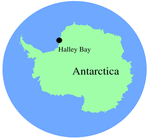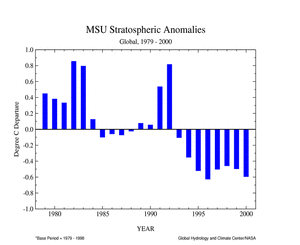|
|
The Antarctic Ozone Hole was discovered by the
British Antarctic Survey from data obtained with a ground-based
instrument from a measuring station at Halley
Bay, Antarctica, in the 1981-1983 period. They reported
the October ozone loss in 1985. Satellite measurements then
confirmed that the springtime ozone loss was a continent-wide
feature.
|

Click
here for larger image
|
|
|
|
Research conducted during the National Ozone Expeditions to
the U.S. McMurdo Station in 1986 and 1987, and NASA stratospheric
aircraft flights into the Antarctic region from Chile in 1987
showed conclusively that the ozone loss was related to halogen
(chlorine)-catalyzed chemical destruction which takes place
following spring sunrise in the Antarctic polar region. The
chlorine is derived from manmade chlorofluorocarbons (CFCs)
which have migrated to the stratosphere and have been broken
down by solar ultraviolet light, freeing chlorine atoms.
The ozone hole is formed each year in the Southern
Hemisphere spring (September-November) when there is a sharp
decline (currently up to 60%) in the total ozone over most of
Antarctica. During the cold dark Antarctic winter, stratospheric
ice clouds (PSCs, polar stratospheric clouds) form when temperatures
drop below -78C. These clouds are responsible for chemical changes
that promote production of chemically active chlorine and bromine.
When sunlight returns to the Antarctic in the Southern Hemisphere
spring, this chlorine and bromine activation leads to rapid
ozone loss, which then results in the Antarctic ozone hole.
Although some ozone depletion also occurs in the Arctic during
the Northern Hemisphere spring (March-May), wintertime temperatures
in the Arctic stratosphere are not persistently low for as many
weeks which results in less ozone depletion.
Owing to regulations on the production and use
of certain ozone-destroying chlorinated compounds, which went
into effect in January 1996, the atmospheric concentration of
some of these man-made substances has begun to decline. Chlorine/bromine
should reach maximum levels in the stratosphere in the first
few years of the 21st century, and ozone concentrations should
correspondingly be at their minimum levels during that time
period. It is anticipated that the recovery of the Antarctic
Ozone Hole can then begin. But because of the slow rate of healing,
it is expected that the beginning of this recovery will not
be conclusively detected for a decade or more, and that complete
recovery of the Antarctic ozone layer will not occur until the
year 2050 or later. The exact date of recovery will depend on
the effectiveness of present and future regulations on the emission
of CFCs and their replacements. It will also depend on climate
change in the intervening years, such as long-term cooling in
the stratosphere, which could exacerbate ozone loss and prolong
recovery of the ozone layer.
|
|
| |
Although increasing greenhouse gas concentrations in the atmosphere
may result in warmer surface temperatures, colder temperatures
are expected to occur in the stratosphere. In fact, temperatures
in the lower
stratosphere, as measured by NOAA's Microwave Sounding
Unit, have cooled during the past 22-years, the length of the
satellite record. Colder stratospheric temperatures can enhance
ozone loss through their affect on the formation of polar stratospheric
clouds which in turn promote chlorine-caused ozone destruction.
|
|

Click
here for larger image |
|

